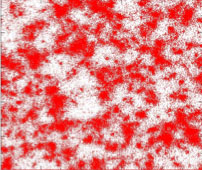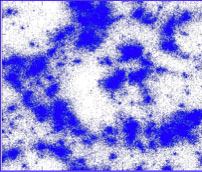Dynamics of self-gravitating systems
A System with long-range interactions is characterized by an inter-particle potential which decays at large distances with a power law exponent which is smaller than the dimension of the embedding space. Classical examples include for instance: self-gravitating systems, unscreened Coulomb systems, ion beams, wave-particle systems of relevance to plasma physics and others.
The behaviour of the above mentioned systems is interesting both from the point of view of stable (or metastable) states, because equilibrium statistical mechanics shows new types of phase transitions and cases of ensemble inequivalence, and from the dynamical point of view, because they display peculiar fast relaxation followed by the formation of quasi-stationary states that are related to the underlying Vlasov-like equation. These characteristics are fundamentally different from those of systems characterized by short-range interactions. Thus, a separate investigation is required for the understanding of their collective behavior.
In particular the problem of formation, via pure gravitational interaction, of complex cosmic structures, such as those observed in present galaxy catalogs (e.g. the SLOAN digital sky survey – SDSS), from a very uniform primordial matter density, such as that predicted in standard cosmological models, is a task of formidable difficulty which attracted much interest in the last decades in the cosmological community.

Super-homogeneous initial conditions
However, despite big progresses in the last two decades, the problem of cosmological structure formation via gravitational interaction from highly uniform and homogeneous initial conditions is still open. More in general the statistical physics and the dynamical evolution of particle distributions characterized by long range mutual interactions is a largely unsolved problem which is attracting more and more interest in the statistical community.
Indeed in the last years, mainly through the deep analysis of an important toy model the Hamiltonian Mean Field model (HMF), we have anyway assisted to important progresses in the understanding of the thermodynamic properties of long-range interacting systems. For example, it has been observed over forty years ago that the microcanonical specific heat of these systems may be negative. This feature has been used to explain phenomena like gravitational collapse in astrophysics.

Moreover, many dynamical features have been observed which distinguish these systems from those with short-range pair interaction. For instance, it has been found that thermodynamically unstable states may be long lived with a relaxation time which diverges with system size giving rise to so-called quasi-stationary states. While such features may be understood on a case by case basis, an overall thermodynamic and statistical mechanics framework is still lacking.
From the point of view of self-gravitating systems, one is interested primarily in understanding the dynamics of infinite self-gravitating systems evolving from initial states with low amplitude fluctuations. The motivation comes from cosmology in which the structures observed at enormous scales in the distribution of galaxies in the universe are postulated to form in this way.

Very strong observational constraints are now available on both the initial conditions (via the measurement of the tiny fluctuations in the cosmic microwave background) and “final” state (via numerous surveys of the distribution of galaxies and other objects in the universe around us
today). In this context, there are several specific issues of considerable importance on which the node expects to benefit from interaction with the other components of the network, notably: (i) the understanding of the extent to which numerical simulations, of a finite number of particles, correctly reproduce the Vlasov/fluid limit described by contemporary cosmological models; (ii) the understanding of the physics giving rise to “halo” structures, the primary building blocks in terms of which the non-linear structure observed in simulations are described; (iii) the existence of spatio-temporal scaling of structure formed in the gravitational collapse. More generally, the goal is to explore the use of instruments from statistical mechanics to understand the formation of structure in these simulations.
References
[1] M. Joyce, B. Marcos, A. Gabrielli, T. Baertschiger, and F. Sylos Labini, “Gravitational evolution of a perturbed lattice and its fluid limit”, Phys. Rev. Lett., 95, 011304 (2005).
[2] B. Marcos, T. Baertschiger, M. Joyce, A. Gabrielli, F. Sylos Labini, “Linear perturbative theory of the discrete cosmological N-body problem”, Phys. Rev. D, 73, 103507 (2006).
[3] T. Baertschiger, M. Joyce, A. Gabrielli, F. Sylos Labini, “Gravitational dynamics of an infinite shuffled lattice of particles”, Phys. Rev. E, 75, 021113 (2007).
[4] T. Baertschiger, M. Joyce, A. Gabrielli, F. Sylos Labini, “Gravitational dynamics of an infinite shuffled lattice: particle coarse-grainings, non-linear clustering and the continuum limit”, Phys. Rev. E, 76, 011116 (2007).

